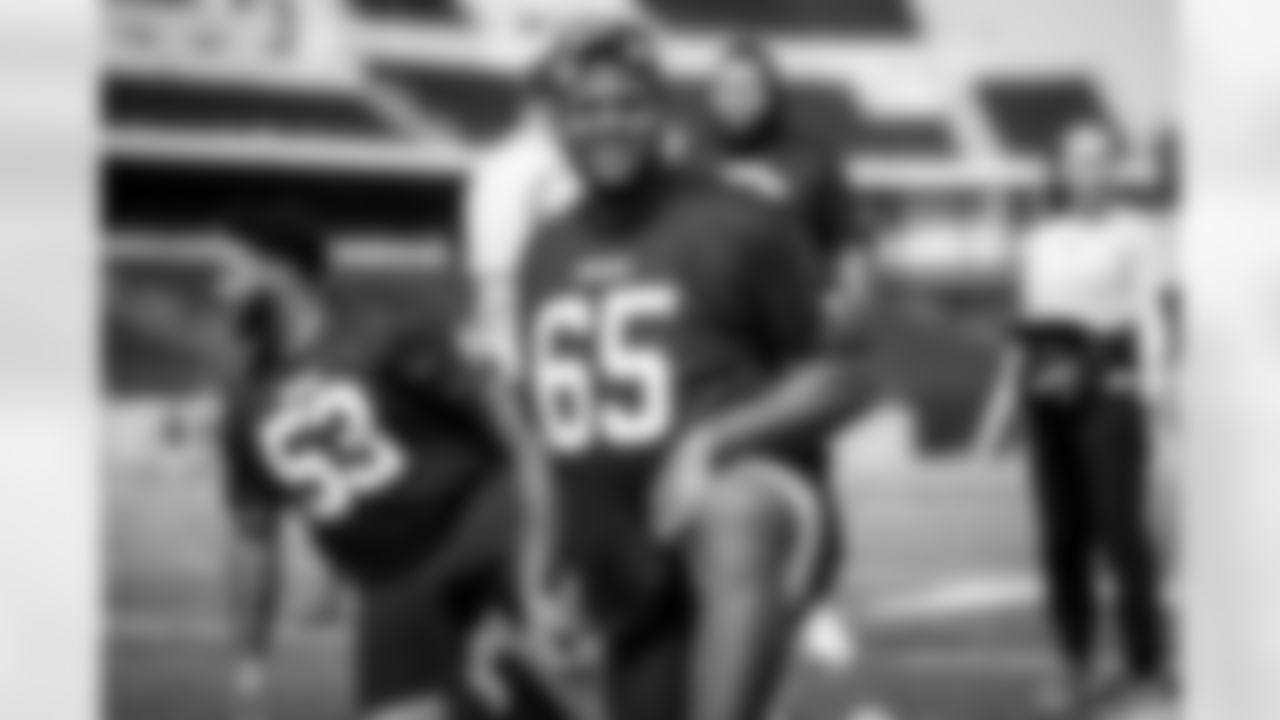Bob Glauber opened the beginning of a presentation for the Browns on the "Forgotten Four" Wednesday at the Pro Football Hall of Fame with a simple question.
"Who here has heard of Jackie Robinson?" asked Glauber, who co-authored a book titled "The Forgotten First" about the four players who re-integrated pro football in 1946, which led to the "Forgotten Four" nickname.
A room full of Browns players, coaches and team personnel all raised their hands, as expected.
"Now, before you got to the Cleveland Browns, who had heard of Bill Willis?" Glauber asked. Willis was a three-time All-Pro who played eight years in Cleveland and is a part of the "Forgotten Four." The group re-integrated the sport's color barrier a year before Robinson did the same for baseball.
Only one hand was raised.
Glauber asked the same question for Browns legend Marion Motley, who spent eight years with Cleveland as a running back. He led the All-America Football Conference in rushing yards in 1948 and led the NFL in rushing yards in 1950, the first year the Browns played in the league.
Two hands were raised.
"You're not alone," Glauber said.
He's right. For decades, the legacies of Willis and Motley — as well as those from Kenny Washington and Lenny Strode, the two other players from "The Forgotten Four" — have largely been stashed in the back corners of football's history cabinet. Glauber, who has covered football since 1985, went decades without hearing about the group.
So did Keyshawn Johnson, who co-authored the book with Glauber and joined the meeting via Zoom. He spent 11-years in the league as a player and seven as a broadcaster, but he didn't know of the men who re-integrated the sport until Glauber approached him with the book idea.
Head Coach Kevin Stefanski didn't want the Browns to fall in the same category.
To ensure his players were enlightened, he organized a presentation during the team's visit to Canton with Glauber and Johnson, as well as Bill Willis Jr., Clem Willis and Tony Johnson Motley — the family members of Willis and Motley — to share stories about how "The Forgotten Four" changed the game.
"You have to tell these stories, as uncomfortable as they may be," Stefanski told the group. "We have to own that, and we already are making a difference."
Check out photos of players and coaches working throughout the offseason

Offensive guard Wyatt Teller (77) and Offensive guard Joel Bitonio (75) during the second day of Veteran Minicamp at the Pro Football Hall of Fame in Canton, Ohio on June 15, 2022.

Offensive tackle Elijah Nkansah (65) during the second day of Veteran Minicamp at the Pro Football Hall of Fame in Canton, Ohio on June 15, 2022.

Offensive guard Wyatt Teller (77) during a tour of the Pro Football Hall of Fame in Canton, Ohio on June 15, 2022.

Linebacker Sione Takitaki (44) during the second day of Veteran Minicamp at the Pro Football Hall of Fame in Canton, Ohio on June 15, 2022.

Defensive tackle Perrion Winfrey (97) during a tour of the Pro Football Hall of Fame in Canton, Ohio on June 15, 2022.

Browns players and staff heard from family members of Bill Willis and Marion Motley as well as Keyshawn Johnson before a tour of the Pro Football Hall of Fame in Canton, Ohio on June 15, 2022.

Offensive Line Coach Bill Callahan and Head Coach Kevin Stefanski during a tour of the Pro Football Hall of Fame in Canton, Ohio on June 15, 2022.

Wide Receiver David Bell (18) during the second day of Veteran Minicamp at the Pro Football Hall of Fame in Canton, Ohio on June 15, 2022.

Browns players and staff heard from family members of Bill Willis and Marion Motley as well as Keyshawn Johnson before a tour of the Pro Football Hall of Fame in Canton, Ohio on June 15, 2022.

Cornerback Reggie Robinson II (31) during the second day of Veteran Minicamp at the Pro Football Hall of Fame in Canton, Ohio on June 15, 2022.

Wide receiver Travell Harris (83) during a tour of the Pro Football Hall of Fame in Canton, Ohio on June 15, 2022.

Tight end David Njoku (85) during a tour of the Pro Football Hall of Fame in Canton, Ohio on June 15, 2022.

Safety Grant Delpit (22) during the second day of Veteran Minicamp at the Pro Football Hall of Fame in Canton, Ohio on June 15, 2022.

Browns players and staff heard from family members of Bill Willis and Marion Motley as well as Keyshawn Johnson before a tour of the Pro Football Hall of Fame in Canton, Ohio on June 15, 2022.

Physical Therapist Anthony Trem and Linebacker Jacob Phillips (50) during the second day of Veteran Minicamp at the Pro Football Hall of Fame in Canton, Ohio on June 15, 2022.

Browns players and staff heard from family members of Bill Willis and Marion Motley as well as Keyshawn Johnson before a tour of the Pro Football Hall of Fame in Canton, Ohio on June 15, 2022.

Wide Receiver David Bell (18) during a tour of the Pro Football Hall of Fame in Canton, Ohio on June 15, 2022.

Browns players and staff heard from family members of Bill Willis and Marion Motley as well as Keyshawn Johnson before a tour of the Pro Football Hall of Fame in Canton, Ohio on June 15, 2022.

Head Coach Kevin Stefanski during the second day of Veteran Minicamp at the Pro Football Hall of Fame in Canton, Ohio on June 15, 2022.

Quarterback Deshaun Watson (4) during the second day of Veteran Minicamp at the Pro Football Hall of Fame in Canton, Ohio on June 15, 2022.

Offensive guard Joel Bitonio (75) during the second day of Veteran Minicamp at the Pro Football Hall of Fame in Canton, Ohio on June 15, 2022.

The locker room before the second day of Veteran Minicamp at the Pro Football Hall of Fame in Canton, Ohio on June 15, 2022.

Linebacker Anthony Walker Jr. (5) during the second day of Veteran Minicamp at the Pro Football Hall of Fame in Canton, Ohio on June 15, 2022.

Running back Jerome Ford (34) and Offensive tackle James Hudson III (66) during the second day of Veteran Minicamp at the Pro Football Hall of Fame in Canton, Ohio on June 15, 2022.

Running back Demetric Felton (25) during the second day of Veteran Minicamp at the Pro Football Hall of Fame in Canton, Ohio on June 15, 2022.
Bill and Clem are the sons of Willis, while Tony is the grandson of Motley. They recalled the stories their relatives passed down about the obstacles they faced in reaching the status of a professional football player.
Both players, for instance, were not allowed to travel with the Browns for a game to Florida, where it was illegal for Black players to play against white players. When they did play, opposing players often hit them late after the whistle or intentionally stepped on them. Glauber even shared that one player going against Willis put razor blades in his hand wraps.
But despite all the unfairness and hatred around them, Willis and Motley kept playing.
That's because they had a Browns team that supported them.
"These guys just stood up, kept their heads down and didn't retaliate," Clem told the room. "They stuck together as a team, and that's how they persevered. Those were different times, but we're so glad they pioneered and persevered so we are where we are today."
The presentation was a core part of what Stefanski hoped to achieve with the Browns, both in the visit to the Hall of Fame and overall offseason program. He's prioritized team-building activities now that pandemic restrictions have enabled the Browns to socialize in the building and conduct a normal offseason for the first time since he became head coach in 2020.
One way to bond the team even more? Enlightening everyone about the importance and legacies of two of the most influential players in franchise history.
"I just think this story is so powerful," Stefanski said. "We're so lucky to be a part of the story and have the Bill Willis and Marion Motley family as part of the Cleveland Browns story."















